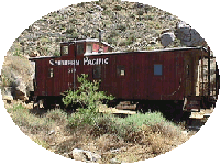Chapter 3: Interlude....the Caboose, Part I
Ok; raise your hand if you know how long the caboose was around? Forever you think....well, close to it. Plus/minus 140 years, give or take a few, in one form or another. Any idea on how it got its name? I didn't either, but was curious.
The generally accepted derivation seems to come from the days of early sailing ships where sailors often set up box-like shelters around their stoves on the ships deck to protect the fires and protect themselves. The Dutch called 'em kabuises; the Germans, kabuses. The English called the ships galley a "caboose".
Now, how in the world you ask, did a railroad car in the United States come to be called a "caboose". Not as far fetched as it seems...follow along.
During the early years of railroad building around the US, but particularly in the midwest and out west, the work trains consisted of flat cars and box cars which were used to transport men and materials. No "news" here, right. But the crew boss and the road forman had really no place to do their work...bills of lading, time sheet, material and food orders, etc., so it became common practice for them to arrange a flat car to be placed at the end of the train, back from the engine smoke and the work area, where they could "hang-out". They used nail kegs and boards as tables/chairs. An evolvement of this was adding a heating/cooking stove on the car. One problem they kept having....the wind and heat/cold. So, a simple soultion was to build shelter "boxes" around themselves. Ah-HA!!!! Did the "light just come on"?!! Get the connection!!! As lots of the railroad workers were immigrants from Europe.....the transitioning of ship terminology to rail terminology was inevitable....and the Dutch, German pronunciaton was "Englishized"
Little "shelter boxes" on vessels sailing along on water.....to vessels sailing along on rails.....HEY!!! Works for me!!!!
Next Chapter....the caboose evolves.
Wednesday, November 11, 2009
Subscribe to:
Post Comments (Atom)

No comments:
Post a Comment